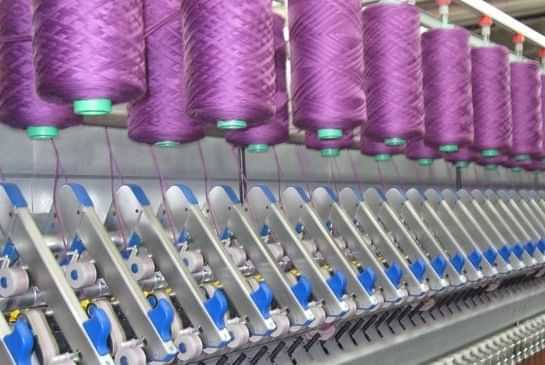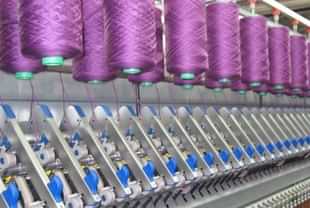Business
Indian Textile Machinery Makers Upbeat On Loosening Chinese Hold In Domestic, Export Markets, Post-Covid-19
M R Subramani
May 06, 2020, 12:43 PM | Updated 01:19 PM IST
Save & read from anywhere!
Bookmark stories for easy access on any device or the Swarajya app.


Indian textile machinery manufacturers are hoping to take full advantage of the global anti-Chinese sentiments following the outbreak of novel Coronavirus (Covid-19) pandemic.
The pandemic, which originated in China, has affected almost all countries across the globe with the United States and European countries being among the worst hit.
The global community is angry and upset with China since it had reportedly not alerted other countries on the outbreak of Coronavirus and the problems it was facing due to it.
Various countries are now trying to express their disappointment with the Chinese attitude, including by looking for substitute products from other countries and pulling out their investments from China.
One reason why the textile machinery manufacturers in the country are upbeat on their prospects, post-Covid-19, is that they see this as an opportunity to increase their share in the domestic market that is dominated by imports.
According to Textile Excellence, imports make up 83 per cent of Indian textile machinery trade, the fourth largest in the world.
In 2018, the Indian textile industry imported machinery worth $4.02 billion, while $840 million worth machinery was exported.
China is the biggest machinery import source for India, making up 36 per cent or $1.45 billion worth shipments into the country.
Japan, Singapore, Germany and Italy are other sources of India’s textile machinery imports.
On the other hand, Bangladesh, Turkey, Germany, Vietnam and the Netherlands are the main buyers of Indian textile machinery abroad.
The Indian textile machinery sector’s growth has nearly doubled between 2011 and 2018.
“We can meet at least 50 per cent of the additional domestic demand for textile machinery post-Coronavirus (to cash in on the anti-Chinese sentiments),” said N D Mhatre, Director-General (Tech), Indian Textile Accessories and Machinery Manufacturers’ Association (ITAMMA).
“As of today, we are meeting only 50 per cent of the domestic demand,” he said.
ITAMMA is the voice of small and medium enterprises in the textile engineering and accessories industry with 400 units being its members.
While more competitively-priced machines come to India from China, the expensive ones come from Europe.
The decision of Europeans to transfer their technology and outsource production to the Chinese has helped China gain an upper hand in the textile machinery trade.
“Due to Coronavirus, exports and imports of textile machinery from European countries is nearly nil. This trend will continue for a year or two. India can make use of this opportunity especially in working out technology transfers/joint ventures that can help strengthen our machinery with state-of–the–art technology base. Thus, our machinery exports to countries such as Indonesia, Vietnam and Bangladesh would further be enchanced,” Mhatre said.
India is a net importer of textile machinery not because of any slackness on the part of the industry.
Lakshmi Machine Works (LMW), Coimbatore, is a very good example of the most renowned and competent spinning machinery manufacturer in India, the ITAMMA official said.
Besides the Coimbatore-based LMW, Indian firms such as Kirloskar Toyoda Textile Machinery, Rieter and Veejaylakshmi Engineering Works are viewed as strong competitors in the global textile machinery trade.
One reason why the Indian textile industry has till now gone for imports from China is because of the Chinese offering, for example, high-speed looms at Rs 4-5 lakh.
“And because of this benefit in cost range, many Indians (textile product manufacturers) go for Chinese looms, thus registering a benefit of more number of looms in low project cost value,” said Mhatre.
If, for example, an Indian textile product manufacturer opts to buy some 50 machines, it helps the company cut its costs by about Rs 1 crore.
“Keeping in mind that any project should be sustainable, one has to go for good technology and long lasting machines instead of cheap and less-life machines as one cannot afford to change the machines frequently before the pay-back period. Thus, it is time now to change the culture in the country of importing cheap,” the ITAMMA official said.
The recent dissatisfaction expressed by many textile manufacturing units over Chinese machinery not being sturdy and sustainable could now change the fortunes of the indigenous textile machinery manufacturers for good.
The other disadvantage of Chinese machinery is that they offer no new technology. The Chinese produce a large number of machines mechanically without much design elements.
What helps them is that they do not hesitate to scrap their excess production.
As a result of this, not all machinery manufacturing units are working at installed capacity, says a research study by Indian Textile Machinery Exhibitions society.
Mhatre said Indian machinery manufacturers can take up techno-commercial products from the Europeans as its potential is unrealised.
Since the European industry has come to a halt due to Coronavirus and will take time to get back on its feet, industry experts view this as a golden opportunity for India to fill the void.
Indian textile machinery manufacturers can achieve the level of Europeans technology and export too, Mhatre said and added that ITAMMA has prepared a road map for micro, small and medium enterprises (MSME).
MSMEs make up 80 per cent of the total textile machinery industry.
“We have conducted online training and webinars for MSMEs. We can set up state-of-the-art facilities to improve the product technology, save wastage and help in time management,” the ITAMMA Director-General (Tech) said.
This will help improve productivity, too. On the other hand, joint ventures with companies abroad, especially Europeans ones, can also benefit the industry.
Mhatre said indigenous technology was also available and it could be exported. Indian machine makers, in collaboration with Vietnam, can bridge the technology gap and export to buyers abroad.
Experts see great scope with the latest computer-aided designs and digitisation.
The latest changes made in the Textile Upgradation Fund (TUF) Scheme for the textile industry also favours the machinery manufacturers.
Under the old TUF Scheme, the textile product makers could import machinery that was 15-20 years old.
“Under the new TUF Scheme, machinery with only the latest technology can be imported,” said Mhatre.
With the right kind of policies, India could even draw a couple of machinery manufacturers from Europe to share technology with Indian machinery makers. If a few of them come forward, the Indian industry could gain a lot, said industry experts.
“Indian textile machinery manufacturers can offer good value for money. We have done a lot of research but are unable to understand why they have not been adopted,” said the ITAMMA official.
Probably, the textile manufacturers can go in for reverse engineering or opt for applied research, he said.
The bottom line is the textile machinery makers are upbeat on their prospects in the domestic and global market post-Coronavirus situation.
(This is fourth in a series of five articles on the Indian textile industry post-Covid-19 situation. The first appeared on 29 April, the second on 1 May and the third on 4 May. The last one will appear on 8 May.)
M.R. Subramani is Executive Editor, Swarajya. He tweets @mrsubramani





